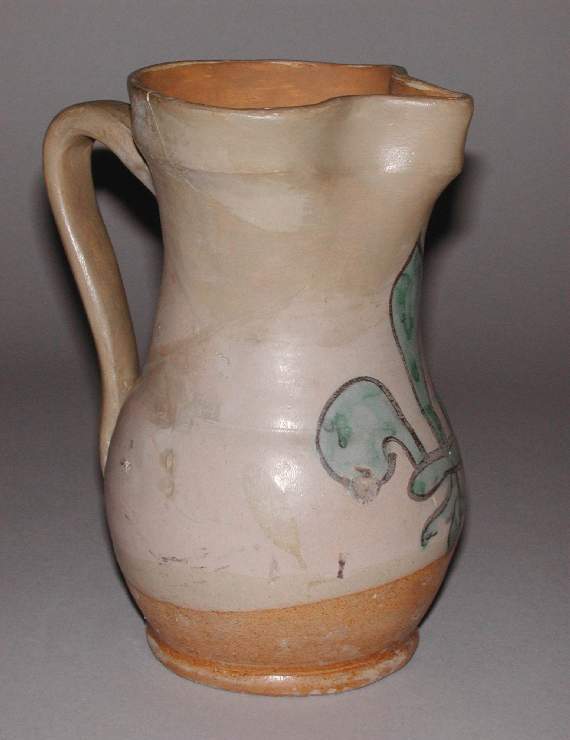Current Location: In storage
Maker(s)
Pottery:
Unidentified Orvieto pottery
(Probably)
Entities
Categories
Description
Late Medieval maiolica jug, painted in black and green, with on the front a fleur-de-lis.
Earthenware. The interior, lower part, and base are lead-glazed brown; the rest is tin-glazed greyish-beige. Painted in black and copper-green.
Shape 11. Bulbous body with disk base, cylindrical neck, carinated rim, pinched spout and loop handle of D-section.
On the front there is a green fleur-de-lis outlined in black.
Notes
History note: Signor Avvocato Marcioni or Cavaliere Capitano Lucatelli; Sotheby's, 16-17 February 1914, Catalogue of the collections of early Italian pottery formed by Signor Avvocato Marcioni and Cavaliere Capitano Lucatelli of Orvieto, lot 71 (1). William Ridout; Christie's, 13 December 1938, part of lot 105; H.S. Reitlinger (d.1950); the Reitlinger Trust, Maidenhead, from which transferred in 1991.
Legal notes
H.S. Reitlinger Bequest, 1950
Measurements and weight
Height: 17.0 cm
Acquisition and important dates
Method of acquisition: Bequeathed
(1950)
by
Reitlinger, Henry Scipio
Dating
13th Century, Late
14th Century
Medieval
Circa
1275
CE
-
1375
CE
Note
The fleur-de-lis occurs on medieval maiolica as a heraldic device on shields, or as an independent decorative motif. It was associated with the house of Anjou whose arms were azure semé-de-lis or differenced by a label of five points gules, and it would therefore have been an acceptable decorative motif on pottery used by Orvieto's Guelphs led by the Monaldeschi. However, its frequent use on Orvieto pottery during the late thirteenth, and fourteenth, century more probably reflects the fact that it was a charge on the shield of the Farnese (who were closely associated with Orvieto from the early twelfth century), and on those of the Montemarte, Marsciano, and Dolci families of Orvieto. When the complete arms are not shown, the fleur-de-lis is usually single so it is not possible to associate it with a specific family. The motif also occurs on maiolica from Lazio.
School or Style
maiolica arcaica
People, subjects and objects depicted
Components of the work
Interior, Base
composed of
lead-glaze
( and lower part)
Decoration
composed of
high-temperature colours
( black and copper-green)
Exterior
composed of
tin-glaze
Body
Diameter 10.7 cm
Base
Diameter 8.5 cm
Handle To Spout
Width 13.7 cm
Materials used in production
Earthenware
Inscription or legends present
Inscription present: circular with blue border
- Text: 'WILLIAM RIDOUT COLLECTION' printed in blue, 'O/51.' in blue-black ink
- Method of creation: Printed in blue and inscribed in blue-black ink
- Type: Label
Inscription present: brown tie-on
- Text: 105/18
- Method of creation: Inscribed in pencil
- Type: Label
- Text: 71
- Location: On base
- Method of creation: Inscribed in pencil
- Type: Inscription
References and bibliographic entries
Identification numbers
Accession number: C.50-1991
Primary reference Number: 47481
Packing number: EURCER 900
Stable URI
Audit data
Created: Saturday 6 August 2011
Updated: Tuesday 30 April 2024
Last processed: Wednesday 14 May 2025
Associated departments & institutions
Owner or interested party:
The Fitzwilliam Museum
Associated department:
Applied Arts





